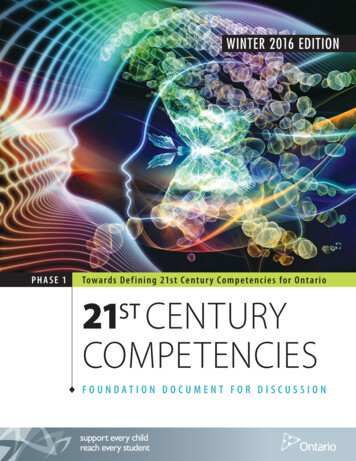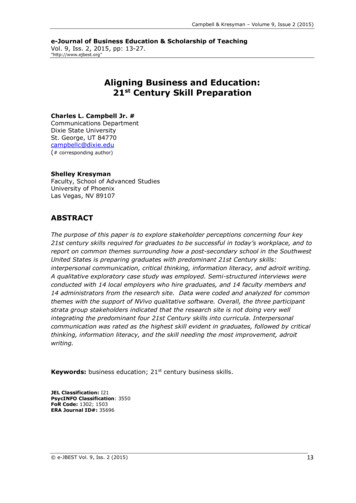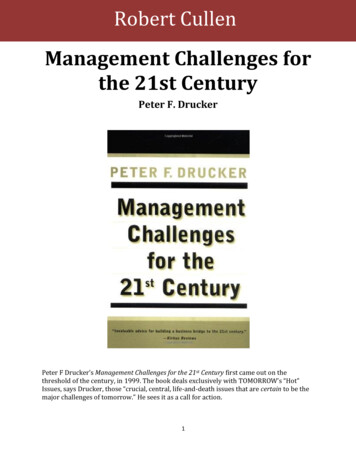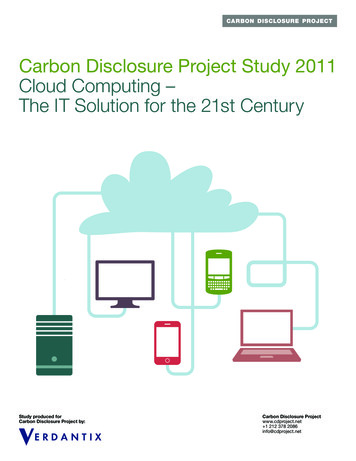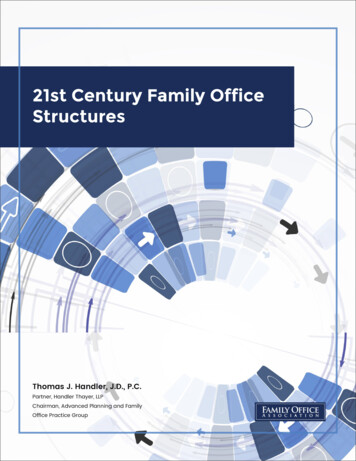
Transcription
21st Century Family OfficeStructuresThomas J. Handler, J.D., P.C.Partner, Handler Thayer, LLPChairman, Advanced Planning and FamilyOffice Practice Group
21 ST C E N TU RYFA M I LY O FFIC EST R U C TU RESSome scholars have even suggested that familyoffices began during the Roman Empire.3These historical family office structures were intimatelytied to the businesses that created the wealth of thesehighly affluent families. Family offices and familyFamily offices, largely unknown twenty-five yearsago, have emerged as the twenty-first century globalbest-in-class solution for affluent families strivingto achieve long-term wealth management andpreservation. The global proliferation of ultra-highnet-worth (UHNW) families in recent years has fueledthe establishment and development of these offices.Moreover, family offices of all types are expected toincrease in number.1A family office can generally be defined as a private2family business designed to manage and preserve thewealth of the proprietary family. Using this definition,numerous entrepreneurial merchant families inthe nineteenth and twentieth centuries establishedvarious businesses that could be called family offices.Moreover, these family office enterprises were usedby affluent families during the Industrial Revolution tomanage and invest in new business opportunities.2businesses are inextricably tied together; the familyoffice is simply another business enterprise run orretained by the entrepreneurial family. In the UnitedStates, 55% of all families with single-family offices(SFOs) run one or more operating businesses.4 Asa result of this connection, most early family officestructures, commonly organized in one of two differentarrangements, were defective in important ways.One defective structure typical of early family officesis often called the “upside-down” model. This structureresulted from the use of trusts as the primary vehicleFamily offices haveemerged as the 21stcentury global best-in-classsolution for affluent familiesstriving to achieve longterm wealth managementand preservation.1 - Rosplock, K. & Hauser, B.R., “The Family Office Landscape: Today’s Trends and Five Predictions for the Family Office of Tomorrow.” The Journal ofWealth Management, 7.3, pg. 9. 2014.2 - Fernandez-Moya, M. & Castro-Balaguer, R., “Looking for the Perfect Structure: The Evolution of Family Office from a Long-Term Perspective.” Universia Business Review 82, 84. 2011.3 - Id.4 - “5th Annual Single Family Office Study.” Family Wealth Alliance. 2012.21st Century Family Office Structures Thomas J. HandlerPresented by Family Office Association
for holding assets in the nineteenth and early twentiethThe most common problem with this structurecenturies. The trustees, often together with familyoccurred when the family, acting through the familymember beneficiaries, would determine to establishoffice, made a decision with respect to the investmenta family office. The trustees, already in completeor distribution of its assets, only to be vetoed by thecontrol of the assets, established many of these earlytrustee in complete frustration of family objectives.family offices. These structures then left the trusteesThe upside-down element of the structure, then, isstill in complete charge of family assets as well asthat decision-making authority does not rest with thethe newly established family offices. This left affluentprivate family through its family office, but with thefamilies clearly in a distinct second position behindtrustees alone.the trustees, especially given the limited options thatfamily members had for holding trustees accountableThe second defective structure is commonly referredunder the trust designs common before the lateto as the “embedded” family office because notwentieth century.separate family office legal structure actually exists.5Instead, its functions are carried out inside one ormore family business enterprises. In effect, the familyChart 1Historical Upside-Down Family Office Structureoffice operations are embedded inside the familyoperating businesses.3TrusteeTrustSingle Family OfficeFamily Beneficiary 2003 Handler Thayer, LLP21st Century Family Office Structures Thomas J. Handler5 - Thomas J. Handler, Establishing Virtual Family Offices, Trusts & EstatesMagazine 41, 41-42 (2014).Presented by Family Office Association
Chart 2Embedded Family Office StructureMerchantFamilyFamily OperatingBusiness FamilyWealthFamilyEmployees 2012 Handler Thayer, LLP4This practice of carrying out family office operations inside a family operating business, using business employeesand business resources, is often attended by numerous breaches of contract, breaches of fiduciary duty,conflicts of interest, tax reporting violations and ERISA6 violations without precise cost accounting allocations andauthorizing legal documents.7 The simple reality is that the use of business personnel or resources for personaluses, investment or asset management is actionable self-dealing. Similarly, operating companies cannot deductexpenses incurred for investment, asset protection, personal tax planning, estate planning or similar purposes ontheir income tax returns.21ST CENTURY FAMILY OFFICE STRUCTURES BEGIN TO EMERGESFOs are dedicated to the long-term wealth management of a single family. As SFOs slowly began to take holdprimarily in North America and Europe in the post-World War II environment, these modern family office enterpriseswere almost universally structured as stand-alone business entities, often with a single purpose. Such enterpriseswere primarily investment advisory businesses that were rarely integrated with a family’s income tax planning,6 - The Employee Retirement Income Security Act of 1974 is a federal law that sets minimum standards for most voluntarily established pension and health plans in private industry to provide protection for individuals in these plans.7 - Handler, supra note 5, at 41-42.21st Century Family Office Structures Thomas J. HandlerPresented by Family Office Association
estate planning, asset protection planning andCHOICE OF ENTITY CONSIDERATIONSpremarital planning objectives and structures.In the United States, almost all family offices arestructured as Subchapter C corporations, SubchapterBeginning in the late 1980’s, these enterprisesS corporations or limited liability companies (LLCs).began to evolve into more sophisticated structureswhich continue to serve as the hub for coordinated,comprehensive and integrated long-term wealthSimilarly, family offices around the world are oftenstructured as traditional corporations and theirequivalents or as LLCs and their equivalents. Of course,management strategies. Concurrently, wealthfamily offices can be structured as proprietorshipsmanagement firms and SFOs began to morph intoor one of the many forms of partnerships; however,multi-family offices (MFOs), which manage the wealthof two or more unrelated families and create synergiesand economies of scale among them. A subset ofsince these entities carry unwanted personal liabilityto one or more owners, such entities are generally notsuitable as family offices.MFOs has been called the “affiliated multi-familyoffice” because it is affiliated with a financial institution,trust company or bank.8 Virtualfamily offices (VFOs), familyoffices with the functions ofan SFO contained within legal5structures, but without separateIn the current marketplace, the majorityof VFO and SFO structures are outdated,not well integrated and poorly structuredby modern best-in-class standards.office facilities, were created assome SFOs began outsourcingIn the current marketplace, the majority of VFO andall or most traditional family office services.9ThisSFO structures are outdated, not well integrated andresult was obtained largely due to the escalating costsand declining margins being experienced by VFOs andSFOs as the super-UHNW market began to mature.10Other compelling reasons supporting the proliferationof VFOs are to provide accounting integrity and toserve a defensive function against common noncompliant business practices.11poorly structured by modern best-in-class standards.These structures were established many years beforethe development of current income tax, estate tax,benefits, executive compensation, asset protectionand premarital planning laws which have effectivelyrendered them obsolete. Other family offices wereestablished looking only to business law purposes8 - Burri, M. and Reymond, O. “The family office: Fleeting trend or lasting values?,” Journal of Financial Transformation, Vol. 15, pp 76-78. (2005)9 - Handler, supra note 5, at 41-42.10 - “The Family Office Dynamic: Pathway to Successful Family and Wealth Management.” Credit Suisse Securities (USA) LLC. 1 Jan. 2016 df 11 - Handler, supra note 5, at 41-42.21st Century Family Office Structures Thomas J. HandlerPresented by Family Office Association
without considering taxation and wealth preservation principles. Most often, prior family office structures weredetermined without a view to comprehensive, integrated advanced planning or consideration of enlightened familygovernance principles.The size of assets under management (AUM) plays an important role in determining the appropriate structure andchoice of entity. In this regard, some general parameters have emerged. VFO assets range from 25 million to over 1 billion in AUM, with most VFOs running 50 million to 500 million in AUM. SFO assets range from 250 million tobillions of dollars in AUM, with most SFOs running 500 million to 5 billion in AUM.Multi-family offices are often started by one or two large SFOs. Consequently, MFO assets typically exceed 500million, while most MFOs start with over 1 billion in AUM. Industry trends show AUM ranges and averages slowly butconsistently increasing over the last twenty-five years as rising family office costs outpace revenues.12Chart 3Family Office AUM Ranges by Structure25M650M250M500M1B5B10B VFOSFOMFO 2016 Handler Thayer, LLP12 - Family Wealth Alliance, supra note 4.21st Century Family Office Structures Thomas J. HandlerPresented by Family Office Association
IMPACT OF GOVERNMENT REGULATION AND FUNCTIONWhen determining the appropriate family office structure, one must consider both the planned and future servicesto be provided and applicable government regulation to which they may be subject. As families, family officeexecutives and their professional advisers discuss family offices, they often refer to them as though they were asingle enterprise, when, in fact, SFO structures are often comprised of several enterprises. The structure and nature ofsome of these entities are determined by regulatory, liability and asset preservation considerations. These structuresinclude the family office management entity in addition to related and ancillary entities.The most common related family office entities include ancillary family offices, real estate property managementcompanies, captive insurance companies, registered investment advisors (RIAs), broker-dealers and private trustcompanies (PTCs).Chart 4Complex Family Office dInvestmentAdvisorsReal EstatePropertyManagerBroker-DealerProperty &Casualty InsuranceCaptiveSubsidiaryFamilyOffice 2008 Handler Thayer, LLP21st Century Family Office Structures Thomas J. HandlerPresented by Family Office Association
ANCILLARY FAMILY OFFICEScaptive life insurance companies. In the currentAncillary family offices are typically established toenvironment, these structures have significant capitalhandle an international family’s affairs in a country orand regulatory burdens that generally render themcontinent other than that of the primary family office,inappropriate for all but the very highest net worthcentralizing the wealth management of investments,global families. A captive entity is generally definedbusinesses and family members in these jurisdictions.as an insurance company that has been organizedA similar use of ancillary family offices is to host aprimarily for the purpose of insuring or reinsuringportion of family office services in that enterprise,the liabilities of the owners. It is usually an affiliatedsuch as accounting, reporting, bill paying and taxentity owned by the family to provide different formspreparation, while the primary, control-entity familyof insurance for the various family entities and evenoffice provides the majority of remaining services,some family members. Although it subcontracts someoutsourcing any services not provided by the familyof the insurance risk through reinsurance contracts,office to MFOs.it benefits the family by recapturing significantportions of the cost of third party insurance. As a8REAL ESTATE PROPERTY MANAGEMENT COMPANIESresult, the owners/insureds participate in controllingReal estate property management companiesthe underwriting, claims and investment decisions ofare typically established to isolate real estatethe insurance company, ultimately profiting from themanagement activities for business, liability and assetexperience gains of the company and realizing anyprotection purposes. In this regard, the family officereduced risk management cost savings.is emulating commercial and multi-unit residentialreal estate developers, rehabbers and operators thatThe many reasons to start or continue using asimilarly isolate property management services fromcaptive tend to change in priority as the needs ofother operations and holding companies.the owners evolve over time; therefore, it is essentialto establish the right structure from the beginning. ACAPTIVE INSURANCE COMPANIESproperly structured captive in the correct jurisdictionOver the past few years, many family offices andwill provide the flexibility required to maximize itsfamily businesses have formed their own captivelong-term utility for the owners. Corporations andproperty and casualty insurance companies calledbusiness owners use captive subsidiaries in order to“captives,” providing them the ability to obtain higherretain favorable underwriting experience, maximizelevels of risk coverage, contain insurance coststhe benefits of self-insured retention, lower insuranceand better manage business risks. A number ofcosts and increase cash flow and investment income.legacy SFOs have formed and operated their ownUnder Internal Revenue Code Section 831(b), captive21st Century Family Office Structures Thomas J. HandlerPresented by Family Office Association
property and casualty insurance companies aremore specific, better delineated rules with significantlycurrently allowed to annually receive 2.2 million inmore complexity. Pursuant to these rules, a familyrevenue tax-free13, while the owners/shareholders ofoffice is defined as an entity which only providesthe captive are currently taxed at fifteen or twentyadvice to “family clients,” is wholly owned by familypercent (depending on the taxpayers’ adjustedclients and controlled by family members, and doesgross income), plus possibly 3.8% for the so-callednot hold itself out to the public as an “investment“Obamacare tax” upon any distributions out of theadviser.”17captive.14 The captive ownership structure servesas a powerful vehicle to obtain less expensive, moreThe Securities and Exchange Commission (SEC) hascontrolled and customized insurance coverage withdefined family clients as current and former familya tax-deductible reserve and transition businessmembers, key employees, and certain charities,earnings outside of the estate to heirs as owners ortrusts and not-for-profit organizations funded byshareholders of the captive on a tax-advantagedfamily members or key employees. A key employee isbasis.defined as a person who is either an officer, director,trustee, general partner or person in a similar capacity9DODD-FRANK COMPLIANCEat the family office, an affiliate of the family office, orThe Dodd Frank Wall Street Reform and Consumera person employed by the family office or an affiliateProtection Act (Dodd-Frank Act) effected sweepingfor at least twelve months who participates in theglobal financial regulations in the family office space.15investment activities of the family office in the courseThe Dodd Frank Act provided for full extraterritorialof the employee’s regular duties. If investment adviceapplication and enforcement. Prior to the passage ofis provided to entities that are not family clients, thenthe Dodd-Frank Act, any investment adviser with fewerthose officers, managers or entities need to register asthan fifteen clients was exempt from registration as ainvestment advisers under the IAA and the Dodd Frankregistered investment adviser under the InvestmentAct. Whether or not a person or entity is providingAdvisers Act of 1940 (IAA).16investment advice is determined by a facts-and-The old rules (whichexempted family offices with fewer than fifteen clientscircumstances analysis.under the Private Adviser Exemption or those withunder 25 million in AUM) were replaced with much13 - The Protecting Americans from Tax Hikes Act of 2015 increased the maximum annual premium exclusion limitation from 1.2 million to 2.2 millionwith a provision for future inflation adjustments, effective January 1, 2017.14 - IRC § 331 (2016).15 - See 12 U.S.C. § 5301 – 5641 (codifying the Dodd Frank Act).16 - See 15 U.S.C. § 80b-1 – 80b-21 (detailing the provisions of the IAA).17 - 17 C.F.R. § 275.202(a)(11)(G)-1.21st Century Family Office Structures Thomas J. HandlerPresented by Family Office Association
REGISTERED INVESTMENT ADVISERSconcerning the advantages of investing in securities orA registered investment adviser (RIA) is an investmentmerely providing a list of securities to a client, even ifadviser registered with the SEC or a state’s securitiesthe adviser does not make specific recommendationsagency. The United States SEC regulates investmentfrom the list).advisers under the IAA and the rules adopted underthat statute. If an individual or firm meets the definitionSection 202(a)(11)(A)-(E) of the IAA expresslyof “investment adviser” under section 202(a)(11) ofexcludes certain persons or firms from the definitionthe IAA, registration with the SEC is required unlessof an RIA. In addition to these exclusions, the IAAthey are exempt or prohibited from registration. Undergives the SEC the discretion to exclude other personsthe IAA, an RIA is a person or firm registered withor firms not within the intent of the definition ofthe SEC that: (1) for compensation; (2) is engagedan investment adviser who should be registered.in the business of; (3) providing advice, makingAdditionally, a person or firm that does not meet therecommendations, issuing reports or furnishingcriteria in Section 203A of the IAA or Rule 203A-2 isanalyses on securities, either directly or throughprohibited from registering with the SEC as an RIA.publications.Generally, since the Dodd-Frank Act was enacted,investment advisers with AUM in excess of 100 million10A person or firm must satisfy all three broadlyare now required to register with the SEC, subject toconstrued elements of the definition to be regulatedcertain exceptions. Under the IAA and its related rules,under the IAA. The receipt of any economic benefitthe following three categories of advisers arise: (1)will satisfy the compensation element. The businessSmall Advisers; (2) Mid-Size Advisers; and, (3) Largeelement is deemed to be satisfied even if anAdvisers. Small Advisers with less than 25 million ininvestment advisory business is not the person’s orAUM are generally prohibited from registering with thefirm’s principal business activity if the person or firmSEC, and must register with state regulators, unless anholds himself or itself out as an investment adviserexemption applies. Mid-Size Advisers with 25 millionor as providing advice, the person or firm receivesto 100 million in AUM are also generally prohibitedseparate or additional compensation for providingfrom registering with the SEC, and must register withadvice about securities or the person or firm typicallystate regulators, subject to certain exceptions and theprovides advice about specific securities or specific“buffer rule” for advisers with between 100 million andcategories of securities. The third element, providing 110 million in AUM that is contained in Rule 203A-1(a).advice about securities, is satisfied if the advice relatesLastly, Large Advisers with 100 million plus in AUM areto securities (i.e. advice about market trends, advicegenerally required to register with the SEC. RIAs are21st Century Family Office Structures Thomas J. HandlerPresented by Family Office Association
held to a high fiduciary standard and are obligated tothe manager of hedge funds or private equity funds,obtain the “best execution” of clients’ transactions.as an institutional investment manager under Section13(f), or as a control person under Section 16 of theBROKER-DEALERSExchange Act. Moreover, family offices who are RIAsOther SEC rules may require family offices to registermay have to make additional disclosures if regulatoryas “broker-dealers.” The applicable provisions ofAUM exceeds 150 million pursuant to a recentlythe Securities Exchange Act of 1934 (Exchange Act)issued joint rule by the SEC and the Commoditycovering the registration of broker-dealers areFutures Trading Commission (CFTC). Further, familycontained in Section 15 of the United States Code.18offices may be required to file notices of exemption orSection 15(a)(1) states that it is illegal for a broker-register with the National Futures Association (NFA)dealer to use any means or instrumentalities ofas a commodity trading adviser (CTA) if the familyinterstate commerce to “effect any transactions in,office provides advice regarding certain investmentsor to induce or attempt to induce the purchase oror makes such investments, including commodities,sale of, any security,” unless registered with the SEC.derivatives, futures or options or as a commoditySection 3(a)(4) of the Exchange Act defines a brokerpool operator (CPO) operating a fund for multiplegenerally as “any person engaged in the business ofinvestors.effecting transactions in securities for the account of11others.” Section 3(a)(5) defines a dealer generally asOverall, the reaction to these regulations by most SFOs“any person engaged in the business of buying andhas been to undertake nearly herculean steps in orderselling securities for his own account, through a brokerto avoid registration. This often extreme reluctanceor otherwise.” The definition of the phrase “engaged into register as an RIA or broker-dealer stems primarilythe business” comes from case law and SEC no-actionfrom concern over increased costs and unwelcomeletters. According to these sources, when determiningadministrative work, loss of privacy and confidentialitywhether a person is engaged in the business ofand unwelcome government intervention into privatebuying and selling securities, an important elementlives. The most common approaches include whollyto consider is the regular participation in securitiesoutsourcing the investment function, eliminating fundstransactions.and qualified plans which include non-family clientinvestors and making contributions of non-familyIn addition, family offices may be required to report asclient funds held in foundations.18 - See 15 U.S.C. § 78o(a)(1) (discussing registration of brokers and dealers).21st Century Family Office Structures Thomas J. HandlerPresented by Family Office Association
12PRIVATE TRUST COMPANIESspecific level of wealth that determines when theA Private Trust Company (PTC) is chartered underneed for a PTC may arise, but there are some generalstate law as a trust company that provides trustindustry guidelines. Industry experts believe that theand fiduciary services to an affluent family or SFO.investable asset threshold is approximately 250 toOnce established, private trust companies act as 500 million for an SFO and 20 million for an MFO.the independent trustee for the family’s trusts. A PTCWhile the MFO threshold is much lower, other factorscan be structured to meet the requirements of anare typically involved. Families consider the services ofindependent fiduciary, where the trustee must bean MFO when they feel they no longer can manage (ora corporate trustee and the family desires to retainno longer desire to manage) the family wealth fromgreater control over the administration of the trust.a complexity perspective, and the family generallyThis is especially common where the trust agreementbelieves there is enough accumulated wealth to(often an older agreement) calls for a corporateoutlast the controlling generation’s lifetime. For afiduciary, or the trustee succession has resulted in afamily in need of a PTC, many of the same attributessuccessor corporate trustee. Note that a PTC tends tofor a family office can be found, with the additionalbe a captive entity because it is owned and controlledgoal of more control over the trustee, and less concernby the family. For some families, this high level offor the cost of implementing and maintaining the PTC.control is what they are seeking over a traditionalThe family will seek to replace an existing corporatecorporate fiduciary relationship.trustee with a captive, family-friendly trustee thatwill cater to the family’s needs while satisfying theIf a family office implements a PTC to which itrequirements of a corporate trustee.delegates investment advisory functions, theycan avoid the Dodd-Frank Act registration andThe family’s PTC is controlled by the family, butcompliance burden.19 Certainly, not all families withgoverned by specific corporate governance provisionsfamily businesses or family offices will benefit fromof the company. A common arrangement is to havecreating and maintaining a PTC, and the costs ofa board of directors for the company comprised of aestablishing a PTC can be very high. Nevertheless,significant number of family members. That family-given the right set of circumstances, the addition ofcontrolled board can then hire outside advisersa PTC can complement the family office and familyto handle the day-to-day operations of the trustbusinesses. Because family needs differ, there is nocompany. If a corporate fiduciary previously acted19 - Handler, T., “S.E.C. Registration of Family Offices: Private Trust Companies May Provide One Avenue of Relief.” Trusts & Estates Magazine. 2011.21st Century Family Office Structures Thomas J. HandlerPresented by Family Office Association
as the trustee and custodian over the family’s trustcompanies (SFLLCs). The determination of whichassets, that corporate fiduciary may very likelyentity is best depends on the country, state or provincebe retained by the PTC to serve in a custodial orof organization, the states or provinces of operationadministrative capacity. Thus, the family maintainsand the family’s perception of the importance of costfiduciary decision-making control, a potentiallyefficiencies, liability, asset protection and premaritaluncomfortable role for the corporate fiduciary thatplanning. State and local income tax or franchisecontinues to act in a custodial capacity, a routinetax treatment of specific family holding companiesfunction for the corporate fiduciary.may be a determinative consideration. Another keyconsideration is that pro rata distributions from thoseCOMPREHENSIVE, INTEGRATED STRUCTURESentities will be advisable in the United States and otherWhile early family offices were often organized insidecountries where discounting of the underlying assets isof dynastic trusts, providing very little or no control tosought for estate planning purposes.the proprietary family, the succeeding generation offamily offices were almost universally stand-aloneentities not integrated into a family’s tax, financial,premarital or asset protection planning. Accordingly,these family offices provided services required by13the families but did little to further family advancedplanning, education and governance objectives.In the last twenty-five years, modern family officeshave increasingly been structured to integrate withthe subject family’s advanced planning goals andstructures. The inclusion of family holding companies,the cornerstone of high-end, global advancedplanning, is a key element of modern family officestructures. Such companies can be structured asfamily limited partnerships (FLPs), family limitedliability partnerships (FLLPs), family limited liabilitycompanies (FLLCs) or series family limited liability21st Century Family Office Structures Thomas J. HandlerPresented by Family Office Association
Chart 5Anatomy of a Modern Family OfficeFamilyTrustsFamily TrusteesFamilyFamily Advisor BoardInvestment CommitteeIndependent TrusteesPhilanthropy CommitteeInstitutional TrusteesSuccession & Tax PlanningBoard of ManagersTrust ProtectorsDynastyTrustsFamilyTrustsSpringing MemberFamily OfficeManagement, LLCFamily HoldingCompany I, LLCServiceProvidersIndependent ManagerFamily HoldingCompany II, LLCPrivatePublicBanksBroker-DealersFund InvestmentsDirect InvestmentsRegistered Investment Advisors14Non-Registered Investment e BrokersOther ProvidersOther InterestsExempt InvestmentFundsRegisteredInvestment FundsMutual FundsHedge FundsExchange Traded FundsPrivate Equity FundsOther Investment FundsVenture Capital FundsFund of Funds 2012 Handler Thayer, LLP21st Century Family Office Structures Thomas J. HandlerPresented by Family Office Association
FAMILY HOLDING COMPANIESan FLLC managed by a family office is limited to familyFamily limited liability companies (FLLCs) are themembers, FLLCs’ investment philosophy and policycornerstone of any sophisticated UHNW estat
emerged as the 21st century global best-in-class solution for affluent families striving to achieve long-term wealth management and preservation. 2 21st Century Family Office Structures Thomas J. Handler Presented by Family Office Association 1 - Rosplock, K. & Hauser, B.R.,



